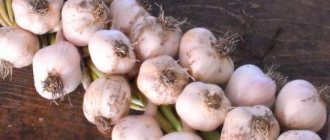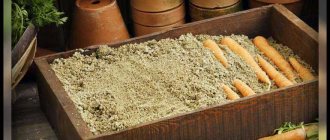How to properly store peeled garlic in the refrigerator?
Before putting garlic in the refrigerator, you need to remember the main storage rules, the implementation of which will help preserve not only the product, but also the beneficial properties included in its composition.
- it is necessary to take only healthy and high-quality cloves, free from the slightest sign of rot, diaper rash and unpleasant odors;
- Even garlic that has been prepared taking into account all the tricks may become unsuitable for consumption over time, so it is necessary to inspect it regularly and, without pity, throw away the one that is affected by putrefactive bacteria or fungus;
- It is strictly forbidden to keep fresh garlic in plastic (including a bag) without ensuring an influx of fresh air, because accumulated moisture will most likely lead to the appearance of mold.
It is best to put the heads or slices in a paper bag, without blocking the air supply, and place them in the far corner of the refrigerator. This way, peeled garlic can remain fresh for a month and wait its turn. It should be remembered that neighboring products run the risk of absorbing the specific aroma of such a preparation.
Preparing garlic for long-term storage
It is extremely important not only to comply with all of the above conditions, successful preparation of garlic begins with its selection. For long-term storage, the winter or spring garlic harvest is sorted, leaving whole, undamaged heads without visible defects.
It is not advisable to store overripe spice heads or cloves with traces of rot or other diseases. This product will not last long!
Spring or winter garlic also needs to be collected at a certain time. The following conditions must be met:
- two weeks before the harvest date, watering should be stopped;
- yellowed and limp leaves signal that the harvest is ripe;
- Harvesting of mature bulbs should be carried out in sunny, dry weather;
- the harvested crop is laid out on a flat surface for drying for two weeks;
- The resulting garlic is prepared in a special way so that it can be stored for a long time.
To prevent garlic from sprouting during storage, its lower part must be burned using a gas burner, stove burner or lighter.
Storing garlic in a jar
This is perhaps the most effective way to keep garlic tasty and healthy for a long time.
For this you will need:
- glass jar;
- vegetable oil (you can use other types: olive, flaxseed, etc.);
- a dark place where the sun's rays do not penetrate.
The following is the procedure:
- The jars must be thoroughly rinsed with hot water and detergent, removing any dirt and foreign odors; then let them dry completely.
- Afterwards you should peel the garlic. You can send both whole heads and slices for storage.
- Place the garlic in a dry jar and pour in oil so that it completely covers the cloves.
- Place this preparation in a dark place; use the product as needed.
A pleasant bonus is that the oil will gradually absorb the specific garlic aroma and can be used to prepare various dishes. For example, for dressing salads. This is a simple and convenient method that does not require cost, time or effort.
How and where to store garlic
There are special varieties adapted for long-term maturation. They are not afraid of temperature changes and are highly resistant to rot, mold, and disease. Among the winter varieties, Podmoskovny, Lyubasha, and Gulliver can be distinguished. Keeping summer varieties - Abrek, Porechye, Sochi.
You should not try to preserve early varieties or winter species for a long time. It makes more sense to prepare such garlic and use it within 2-3 months.
Storing garlic in a box and braids
In the basket
It is convenient to store in a cellar or basement in wicker baskets. They absorb excess moisture and do not interfere with air circulation. It is convenient to check the contents, conduct an audit, and sort through. The only drawback is that it is difficult to buy. Real wicker products were replaced by other containers.
Alternative to baskets:
- carton boxes;
- boxes made of wood, plywood with holes;
- wooden barrels, tubs.
Garlic is often sprinkled with salt, ash, and sawdust. Such materials help regulate humidity levels and prevent rot and mold. The layer will protect healthy heads from damaged specimens.
In braids, nets, pillowcases
Let's look at old, time-tested ways to preserve garlic in the winter at home in a city apartment or private house. Some options have an attractive appearance and are used for kitchen decor. They look bright and original next to bundles of onions, pumpkins, transparent containers with seeds and nuts.
Main types:
- braids . For weaving, it is important not to cut the stems when harvesting. After drying, they are braided, and rope is additionally used. A loop is made from the end for hanging on the wall;
- grids _ They are used in vegetable stores, warehouses, and shops. Mainly made of synthetic materials. You can use knitted nets, string bags;
- cotton pillowcases . Bags will do. The idea is simple - you need to fold the prepared vegetable.
The advantage of the listed methods is their simplicity. The disadvantage is that it is difficult to create suitable conditions. Garlic loses moisture and dries out. When exposed to water, it begins to rot and turn black.
If there are no long stems, instead of braids, we recommend tying bundles of several pieces with ropes. They also look charming in the kitchen, hung or stacked on a shelf.
In a refrigerator
Can be stored in the refrigerator for no more than three months. Then the garlic begins to deteriorate and dry out. You cannot leave vegetables in nets, plastic bags, or throw heads on a shelf without packaging. They will dry out quickly, become limp, and the cloves will turn yellow.
Chopping and storing garlic
Suitable container:
- cotton bags;
- carton boxes;
- paper bags.
Unsuitable:
- plastic bags;
- plastic containers;
- metal containers.
In banks
It is not necessary to store in soft containers. Sometimes it is convenient to use ordinary glass jars. An excellent solution if there is not enough free space in the vegetable department.
Instructions:
- Steam the jars and dry. Or fry in the oven.
- Clean the heads from the husks. Cut off the roots and tails.
- Place in sterile jars.
- Close with a tight nylon lid.
In addition to the refrigerator, filled jars can be stored in the cellar. It is important to periodically sort and remove damaged specimens.
In oil
This option is convenient for unripe heads of garlic, when there are a lot of scattered cloves. There is no need to clean the husks every time before use. The preparation is perfectly stored in the refrigerator for up to three months. Sunflower and olive oil are suitable for filling.
Instructions:
- Heat the oil until almost boiling, then cool.
- Peel the garlic cloves. Do not get it wet.
- Place in a sterile jar.
- Pour in cold oil.
- Put on the lid.
- Place in the refrigerator.
At any time, it’s easy to open the jar, take out a clove of garlic, and use it in various dishes. The aromatic oil is used for dressing vegetable and meat salads, and preparing homemade mayonnaise.
In addition to the peeled slices, you can put hot peppers, sweet peas, coriander seeds, and a clove bud in the jar, cut into rings. The output will be incredibly aromatic oil.
Features of storing garlic
With paraffin
We recommend storing whole, even, ripened heads of garlic this way. When harvesting, leave a stem of 5-7 cm, the rest is cut off. Paraffin prevents moisture loss and protects against rot.
Instructions:
- Remove the roots from the heads, remove the top dirty husk.
- Melt the paraffin. Do not put on fire. Water bath only.
- Dip each head into melted paraffin. Shake off any drops. Place on a wire rack and dry.
- Store in any convenient place. Suitable for kitchen cabinet, pantry, basement. It is advisable to put it in a box or paper bag.
Winter varieties will last in paraffin until February. Spring vegetables planted in spring can be stored until March and April.
Frozen garlic
Can garlic be stored in the refrigerator? Of course you can; and it’s better to do it frozen. This is a quick and easy way to ensure long-term storage of the product without harming its taste.
The action plan is extremely simple: take a clean, new plastic bag, food container or foil. Place garlic in it and place in the freezer. It is best to set the temperature as low as possible. When the housewife needs to take a few cloves, they can be broken off from the total mass and left to defrost at room temperature. It is highly not recommended to use boiling water in this case - it will kill vitamins and other beneficial substances (for example, phytoncides)!
Temperature and humidity conditions for storing garlic
Storage conditions depend on what kind of garlic is grown. Winter varieties are planted in the fall to reap a large harvest. Its heads will lie well at a temperature of +1-4° C and air humidity of 60-80%.
Spring varieties (sown in spring) show good keeping quality at higher temperatures (+15-20° C). At the same time, they require slightly lower humidity - 50-70%. The storage area should definitely not be excessively humid. To prevent the bulbs from rotting, they need air exchange. The container must allow air to pass through; the basement and cellar must be equipped with ventilation. Garlic should never be stored near the battery.
Storing in jars of flour
To do this, you will need a glass jar with a lid (iron or plastic), previously thoroughly sterilized and dried. Peeled garlic is placed at the bottom. Sprinkle flour on top, making sure there are no worms or other parasites in it. Next, close the jar with a lid and place it in a dry place (room temperature is quite suitable for this storage method). You don’t have to worry about flour either - the phytoncides contained in garlic will repel all parasites from it. True, it will acquire a specific smell.
In flour
You can store peeled garlic in a glass jar, sprinkled with flour on top.
To implement this method, you must do the following:
- Rinse the container, sterilize and dry well.
- Cover the base of the container with a 3 cm layer of flour.
- Add a layer of garlic cloves to the jar so that they do not touch each other. Sprinkle a layer of flour on top of the workpiece.
- Repeat layers until container is full. The last layer should be flour so that it fills the container to the neck. This is required to prevent air from entering the jar.
- Seal the container with a tight lid and put it in a dark, cool place.
In this form, garlic can be stored for 60 days.
Storing garlic in salt
Salt is a preservative given by nature. It has long been used to store various products. You will need any container: jar, food container, etc. Sprinkle salt on the bottom, put garlic in it and add plenty of salt again. This way you can make several layers. It is better to store such a workpiece in a dry place out of direct sunlight; and take out the fragrant slices when you need them.
Why does garlic spoil?
If, after several months of storage, the garlic cloves begin to dry out or become covered with brown spots, it means that the storage conditions were not met or an unprepared crop was used.
There are several reasons why vegetables can spoil:
| Cause | How to fix |
| Infected garlic | If a vegetable suffers from bacteriosis, mold or neck rot, it will quickly deteriorate and dry out completely. |
| Conditions regarding harvesting and preparing products for storage were not met | This can happen if there is precipitation during the vegetable harvesting stage. As a result, the garlic heads got wet and did not dry well during the drying stage. In this regard, it is necessary to monitor the weather forecast during the vegetable harvesting period. The weather outside should always be dry and sunny. When precipitation occurs, it is advisable to wait about 4 days so that the soil cover dries well. In this case, 25 days before harvesting, irrigation of the plantings should be completely stopped. Overripe or underripe garlic bulbs can also negatively affect the storage of the product. |
| Failure to comply with storage conditions | Garlic cloves must be kept in a dry place where the air humidity is no more than 70%, and the temperature will not exceed +3 ℃. At home, it is quite difficult to adhere to such conditions. In this regard, it is recommended to put the product in glass containers with an open lid and store it on the mezzanine. To improve preservation and get rid of excess moisture, it is recommended to cover the vegetable with salt or flour. |
| The harvested variety is not suitable for long-term storage | There are garlic varieties that are not suitable for long-term storage. Winter vegetables can be stored for no more than 4 months. Due to this, it will not be able to remain fresh until the next summer season. |
If brown spots begin to appear on the surface of the garlic during storage, it means caramelization of sugars is occurring. It manifests itself due to the loss of moisture from the cloves. The longer the slices lose liquid, the more stains will appear.
In apartment conditions, during the entire storage period, it is necessary to create an optimal balance of moisture, lighting, heat and air so that the peeled garlic remains fresh and can be suitable for further use. If the product is properly maintained at home, it will be able to retain all its taste and aroma.
Garlic salt
Another interesting storage option is to make salt from garlic, which can then be used as an aromatic seasoning for meat and fish dishes. To prepare it, you should thoroughly clean each clove and dry it. Then the resulting raw material must be crushed in any convenient way (for example, using a coffee grinder). The resulting powder is mixed with salt and various seasonings (basil, ground pepper, curry, celery, etc.) in a 1:1:1 ratio until smooth. Store in a dry, tightly closed jar.
Storage problems
It is not always possible to ensure that all storage conditions are observed, and it turns out that the garlic has gone bad.
Garlic dries
Looking through the supplies, dry heads were discovered, as if all the juice had been drunk from them. This occurs as a result of moisture evaporation. To prevent the vegetable from drying out, create a protective paraffin layer or wrap the heads tightly with cling film, this preserves juiciness.
When storing, avoid high temperatures and direct sun, keep humidity at the right level, this will help prevent the vegetable from drying out.
Fungus and mold damage
The appearance of mold on the crop is caused by poor drying before storage or inattentive sorting, when spoiled heads end up in the overall harvest. Fungus and mold spread quickly. Careful harvest preparation is important here. Thorough drying after harvesting will help to avoid such a disaster. It will make conditions unfavorable for the growth of fungi and bacteria.
Germination
A sign of germination is the sprouting of roots by garlic. To prevent this, housewives set the bottom on fire. Such manipulations will extend the shelf life and prevent further germination. The sprouted heads are eaten first or cleaned for storage in vegetable oil.
Rot
Garlic rots in a poorly ventilated area with excess moisture or when placed next to damaged heads. It must be removed from the common container so as not to contaminate other vegetables. For prevention, supplies are periodically sorted and inspected. Thorough drying before storage, as well as separate storage from other vegetables, will help prevent rotting.
Garlic puree
Puree is a great example of how to store garlic in the refrigerator without compromising its taste, smell and beneficial properties. True, it will already be in the form of a sauce that can be served with meat and fish dishes. The garlic cloves should be crushed to a paste (a blender or a special press will do the job perfectly), and then mixed with extra virgin olive oil. This sauce will taste amazing! However, it is not recommended to store it for more than a week.
You might be interested in
- How to store packages: ideas
- Rules for long-term storage of flour
- Storing garlic in the apartment











